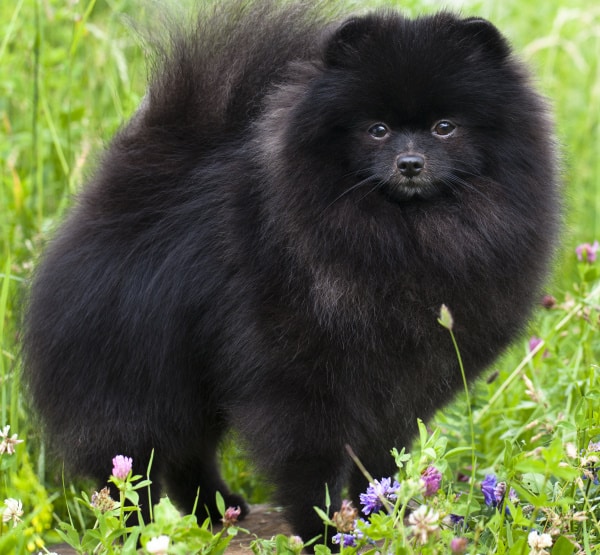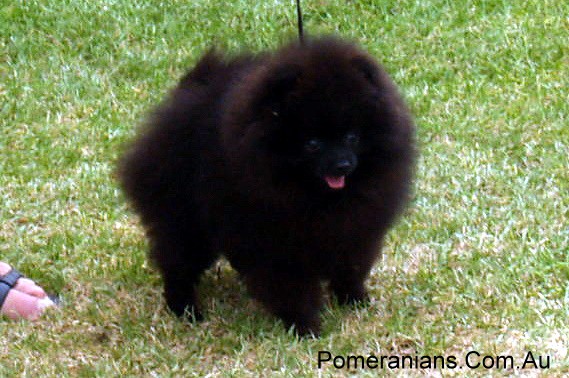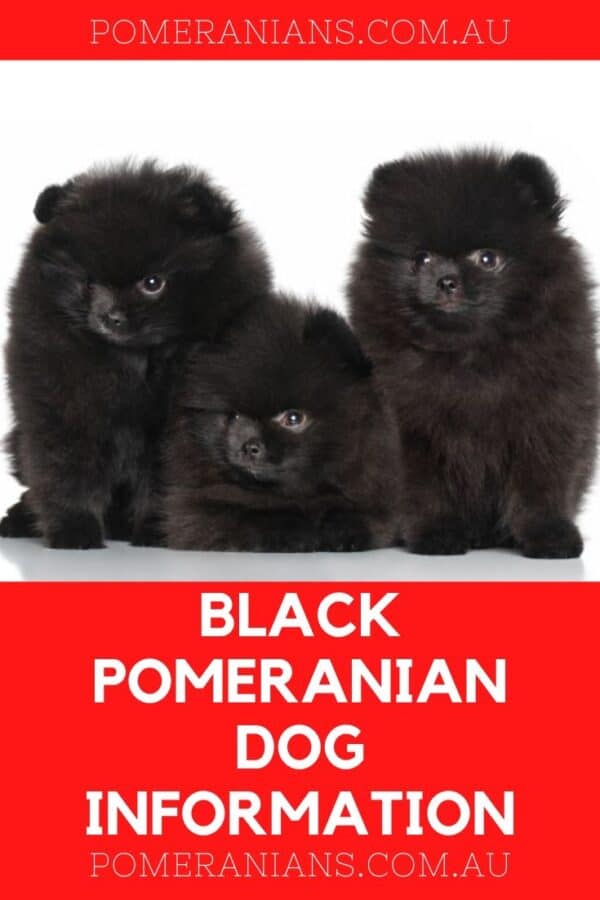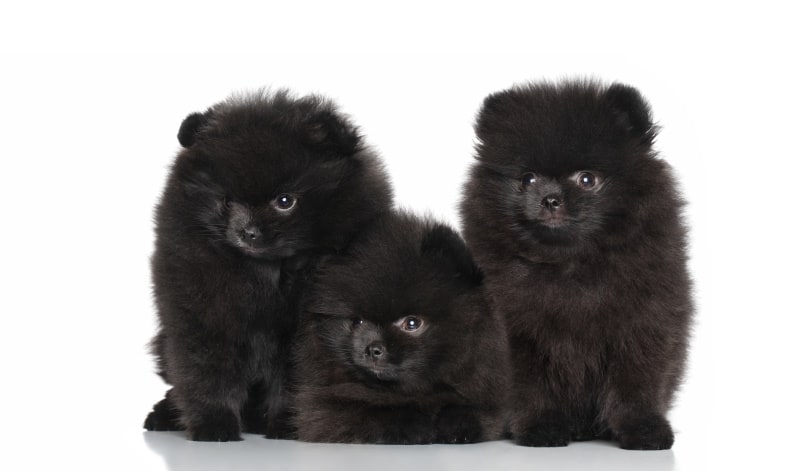Last Updated on April 16, 2024 by Denise Leo
A solid Black Pomeranian dog should possess a coat of black guard hairs with a black undercoat, which should be a “coal black” color. The dog’s coat should be free of any red, white, or brownish fur. The points ( eye rims, pads, lips, and nose) must also be black.
Guard hairs on an adult, the all-black dog should be the same colour throughout the dog’s coat. Exposure to sunlight can cause some burning to the coat, which will appear as red tinges on the fur of Pom dogs who spend long periods outdoors. A black Pom’s undercoat may appear lighter, especially preceding shedding.
Some Pomeranian black puppies often will have greyish tones to their coat during the coat change or puppy uglies stage. This is usually nothing to be concerned about, as when the adult coat comes in the Pomeranian pup’s coat, it will usually change to a solid, bright black color.
A Black Pom will usually have white patches in the coat, even if it is only one or two hairs on the chest area. Mismark Pomeranian puppies are generally the result of using a black and white Pomeranian (a black and white parti Pomeranian) in the breeding program.
Examples of a Pomeranian, usually referred to as a mismark, are a black Pom with one white leg, white feet, or a white collar and blaze.
Black in the Pomeranian also includes the Pomeranian patterns parti-color, white with black patches, brindle Pomeranians, and the black and tan Pomeranian dog.
Black and Tan Pomeranians: As the name suggests, they are black-coloured poms with rust or tan markings.
At Dochlaggie, I have owned, bred, and exhibited numerous black Pomeranians for decades. I have found that Black poms seem to have a temperament and personality all of their own.
History of the Black Pomeranian Dog
Black Pomeranians were highly sought after in the early years of this breed. However, the popularity of black pom declined when orange and sable Pomeranians appeared in the world of Pomeranian dogs. Pomeranian breeders desperately wanted to breed and exhibit the highly desirable orange and orange Sable Pomeranians.
The original colours of the Pomeranian breed were white, black, and cream. In 1803, William Taplin published “The Sportsman’s Cabinet” and mentioned that the black Pomeranian dog was not seen as often as the white Pomeranian and other colours.
William Taplin. The Sportsman’s Cabinet, 1803.
Early in the breed’s history, black Pomeranian breeders mated numerous quality black Pom females to any other colour Pomeranian dogs in an attempt to breed sable Poms.
White and black Pomeranians no longer ranked first in breeding programs and the show ring. There were other colours, such as orange, sable, blue, and chocolate.

Are Black Pomeranians Rare?
The all-black Pomeranian colour is just as popular today as it has been at any time in this toy dog’s history.
All black Pomeranians are NOT one of the rare Pomeranian colours. Although not a rare Pomeranian, a Black Pom dog is not as common or popular as the orange Pomeranians and orange sable Pomeranians. Black Poms still have fans who would not own or even show another coloured Pomeranian.
Where Can I Buy a Black Pomeranian?
Puppy buyers who wish to purchase a black teacup Pomeranian puppy are advised to contact a reputable Pomeranian breeder.
How Much is a Black Pomeranian?
As a Pomeranian breeder, I price my black puppies at the same level as the other standard Pomeranian colors despite the unique appeal and occasionally higher demand for the true black coat.
It’s important to note that Pomeranian prices can vary significantly among breeders. This variance often reflects factors such as the breeder’s reputation, the quality of care the puppies receive, and whether the breeder is considered a responsible source by established entities like the Australian National Kennel Club.
Responsible breeders who invest in their dogs’ health, genetics, and well-being might set a higher price to reflect the quality and ethical standards of their breeding practices.
Black Pom dogs, known for their small size and status as companion dogs, require a significant commitment to regular grooming and health care, which can also influence the pricing structure. When choosing a Pomeranian, potential owners should look for reputable breeders who provide a solid foundation of care and transparency in their pricing and breeding history.
Breeding and Exhibiting Black Adult Show Pomeranians
During the past 100 years, many black toy Poms have won top awards. A Black Pomeranian, Champion Banner Prince Charming owned by Mrs. Frank Smythe won Best in Show at the first American Pomeranian Club Championship Show.
Many black Pomeranians have contributed to and greatly influenced the breed. A recent top-winning black pom was Best in Show Champion Finch’s He Walks on Water. Known at home and to his fans as Travis, Travis has been described as the biggest-winning black Pom in the breed’s history. Travis won 12 Best in Show awards and sired 67 Pomeranian champions.

The black Pomeranian is an important addition to any Pomeranian breeding program. Breeding a black Pom into orange and red Pomeranians enhances the coat’s colour clarity and improves pigmentation in only one generation.
Black is also a very helpful colour to add to a white Pomeranian breeding program. Most successful Pom kennels will include at least one black to improve and maintain these desirable Pomeranian dog qualities.
Personally, I wouldn’t say I like showing a Pomeranian Black dog. Many judges have ignored a good black in favour of the more popular orange and orange sable in the show ring. I have also found that blacks can be more difficult to prepare for the show ring than orange and orange sables.
Another problem is the choice of contrasting-coloured clothing for the handler. Never wear black or dark-coloured clothing when handling any black dog. Light and bright clothing is a much better choice for handlers of dark-coloured dogs.
Breeding Black Pomeranians
Your goals will determine your actions when you attempt to breed black Pomeranians. Don’t breed with Pom dog dilution genes if you want to keep the intensely dark black pigment.
Other black Pomeranians, black and tan Pomeranians, dark orange sable Pomeranians, red sable Pomeranians, and intense red Pomeranians are ideal for breeding quality black Poms.

If you plan to breed black Poms with black Pomeranians for numerous generations without including sable genes, the texture of the coat will likely be lost, but the intense black pigment will remain.
Black Pomeranian Grooming and Black Pom Coat Care
Grooming a black Pomeranian is slightly more difficult than grooming the standard orange or orange sable Pomeranians. This dog’s coat needs special care and attention to appear in the show ring. The black pom is another coloured Pomeranian dog that must be kept out of direct sunlight during summer to avoid any red tinges or sunburning of the coat.
Dog coat conditioning sprays containing sunscreen are a must-have item for a pure black Pomeranian to maintain coat condition.
Black Pomeranian Conclusion
In conclusion, with its captivating true black coat and dark eyes, the black Pomeranian stands out as a striking pure black variant among Pomeranians. Various factors, including genetics, influence the coat color of these friendly dogs.
Potential owners considering a black pom should conduct thorough research. This responsibility can be fulfilled by consulting reputable organizations, such as Australian National Kennel Club breeders, to ensure the Pom litter comes from a reliable source.
Regular grooming is crucial for maintaining their luxurious coat’s solid color and health. Moreover, providing adequate mental stimulation is key to ensuring these small dogs lead happy and fulfilling lives.
Ultimately, black Pomeranians make good pets that thrive in a loving home, embodying a delightful blend of beauty and companionship.
N.B. This article first appeared on the Pomeranian headquarters website and was published here with the author’s permission.
Copyright Pomeranian.Org. All Rights Reserved.
References and Further Reading:
[1] Official Standard of the Pomeranian (AKC). American Kennel Club, 2011.
[2] English Kennel Club Pomeranian Breed Standard, 2017.
[3] Denise Leo “The Pomeranian Handbook“.
[4] Milo G. Denlinger “The Complete Pomeranian”.
[5] Kimbering Pomeranians “1891-1991”.
[6] William Taplin “The Sportsman’s Cabinet”.
[7] E. Parker “The Popular Pomeranian”.
[8] Lilla Ives “Show Pomeranians”.
The Pomeranian Handbook
( Printed and shipped in Australia).



